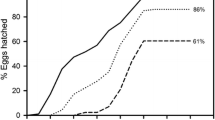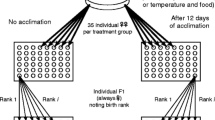Abstracts
Sexual reproduction is density-dependent in several cyclically parthenogenetic rotifer species and induced by a chemical signal produced by the rotifers. As population density increases, the chemical accumulates in the medium until reaching a threshold that triggers sex. The density threshold for sex initiation is of ecological and evolutionary importance due to the large impact that timing of sex has on fitness in cyclical parthenogenetic rotifers. Here we study the effects of experimental methodology in combination with intrinsic features of the biological system on the estimation of the density required to produce enough of this chemical to initiate sex (i.e., density threshold). We have developed a theoretical model describing the dynamics of both population density and the concentration of the chemical signal. Model analysis showed that the time at which sex is recorded in an experiment, the initial density (i.e., experimental volume) and the population growth rate can affect the estimation of density thresholds. Results from an experiment in which density at sex initiation was tested for 29 clones of Brachionus plicatilis at two culture volumes, revealed that density threshold is negatively dependent on the experimental volume. We conclude that in order to estimate density thresholds so that they are comparable across studies, experimental methodology should be standardized.




Similar content being viewed by others
References
Aparici, E., M. J. Carmona & M. Serra, 2001. Variability for mixis initiation in Brachionus plicatilis. Hydrobiologia 446/447: 45–50.
Carmona, M. J., M. Serra & M. R. Miracle, 1993. Relationships between mixis in Brachionus plicatilis and preconditioning of culture medium by crowding. Hydrobiologia 255–256: 145–152.
Carmona, M. J., M. Serra & M. R. Miracle, 1994. Effect of population density and genotype on life-history traits in the rotifer Brachionus plicatilis O.F. Müller. Journal of Experimental Marine Biology and Ecology 182: 223–235.
Carmona, M. J., A. Gómez & M. Serra, 1995. Mictic patterns of the rotifer Brachionus plicatilis Müller in small ponds. Hydrobiologia 313/314: 365–371.
Carmona, M. J., N. Dimas-Flores, E. M. García-Roger & M. Serra, 2009. Selection of low investment in sex in a cyclically parthenogenetic rotifer. Journal of Evolutionary Ecology 22: 2542–2553.
Ciros-Pérez, J., M. J. Carmona & M. Serra, 2002. Resource competition and patterns of sexual reproduction in sympatric sibling rotifer species. Oecologia 131: 35–42.
García-Roger, E. M., N. Dias, M. J. Carmona & M. Serra, 2009. Crossed induction of sex in sympatric congeneric rotifer populations. Limnology and Oceanography 54: 1845–1854.
Gilbert, J. J., 1963. Mictic female production in the rotifer Brachionus calyciflorus. Journal of Experimental Zoology 153: 113–124.
Gilbert, J. J., 2003. Specificity of crowding response that induces sexuality in the rotifer Brachionus. Limnology and Oceanography 48: 1297–1303.
Guillard, R. R. L. & J. H. Ryther, 1962. Studies of marine planktonic diatoms. I. Cyclotella nana Hustedt, and Detonula confervacea (Cleve). Canadian Journal of Microbiology 8: 229–239.
Hino, A. & R. Hirano, 1976. Ecological studies on the mechanism of bisexual reproduction in the rotifer Brachionus plicatilis. I. General aspects of bisexual reproduction inducing factors. Bulletin of the Japanese Society of Scientific Fisheries 42: 1093–1099.
King, C. E., 1980. The genetic structure of zooplankton populations. In Kerfoot, W. C. (ed.), Evolution and Ecology of Zooplankton Communities. University Press, New England: 315–328.
King, C. E. & T. W. Snell, 1980. Density-dependent sexual reproduction in natural populations of the rotifer Asplanchna girodi. Hydrobiologia 73: 149–152.
Ruttner, F., 1930. Das plankton des lunzer untersees. Internationale Review Gesamten Hydrobiologie 23: 1–278.
Schröder, T. & J. J. Gilbert, 2004. Transgenerational plasticity for sexual reproduction and diapause in the life cycle of monogonont rotifers: intraclonal, intraspecific and interspecific variation in the response to crowding. Functional Ecology 18: 458–466.
Schröder, T., S. Howard, M. L. Arroyo & E. J. Walsh, 2007. Sexual reproduction and diapause of Hexarthra sp. (Rotifera) in short-lived ponds in the Chihuahuan Desert. Freshwater Biology 52: 1033–1042.
Serra, M. & C. E. King, 1999. Optimal rates of bisexual reproduction in cyclical parthenogens with density-dependent growth. Journal of Evolutionary Biology 12: 263–271.
Serra, M., T. W. Snell & C. E. King, 2004. The timing of sex in cyclical parthenogenetic rotifers. In Moya, A. & E. Font (eds), Evolution from Molecules to Ecosystems. Oxford University Press, Oxford: 135–146.
Serra, M., T. W. Snell & J. J. Gilbert, 2005. Delayed mixis in rotifers: an adaptive response to the effects of density-dependent sex on population growth. Journal of Plankton Research 27: 37–45.
Serra, M., H. A. Smith, J. S. Weitz & T. W. Snell, 2010. Analysing threshold effects in the sexual dynamics of cyclically parthenogenetic rotifer populations. Hydrobiologia. doi:10.1007/s10750-010-0517-z.
Snell, T. W. & E. M. Boyer, 1988. Thresholds for mictic female production in the rotifer Brachionus plicatilis (Muller). Journal of Experimental Marine Biology and Ecology 124: 73–85.
Snell, T. W., J. Kubanek, W. Carter, A. B. Payne, J. Kim, M. K. Hicks & C. P. Stelzer, 2006. A protein signal triggers sexual reproduction in Brachionus plicatilis (Rotifera). Marine Biology 149: 763–773.
Stelzer, C. P. & T. W. Snell, 2003. Induction of sexual reproduction in Brachionus plicatilis (Monogononta, Rotifera) by a density-dependent chemical cue. Limnology and Oceanography 48: 939–943.
Stelzer, C. P. & T. W. Snell, 2006. Specificity of the crowding response in the Brachionus plicatilis species complex. Limnology and Oceanography 51: 125–130.
Timmermeyer, N. & C. P. Stelzer, 2006. Chemical induction of mixis in the rotifer Synchaeta tremula. Journal of Plankton Research 28: 1233–1239.
Acknowledgments
This study was financially supported by grants from Ministerio de Educación y Ciencia of Spain (CGL2006-07267), Generalitat Valenciana of Spain (ACOMP/2009/030) and the National Science Foundation of US (NSF 0412674), and by fellowships to N. Dimas-Flores by Consejo Nacional de Ciencia y Tecnología of Mexico (171031) and to J. Montero-Pau by Ministerio de Ciencia y Tecnología of Spain (BES2004-5248). We thank two anonymous reviewers for their constructive contribution to our work.
Author information
Authors and Affiliations
Corresponding author
Additional information
Guest editors: N. Walz, R. Adrian, J. J. Gilbert, M. T. Monaghan, G. Weithoff & H. Zimmermann-Timm / Rotifera XII: New aspects in rotifer evolution, genetics, reproduction, ecology and biogeography
Rights and permissions
About this article
Cite this article
Carmona, M.J., Dimas-Flores, N., Montero-Pau, J. et al. Effect of experimental methodology on estimation of density at sex initiation in cyclically parthenogenetic rotifers. Hydrobiologia 662, 131–139 (2011). https://doi.org/10.1007/s10750-010-0519-x
Published:
Issue Date:
DOI: https://doi.org/10.1007/s10750-010-0519-x




